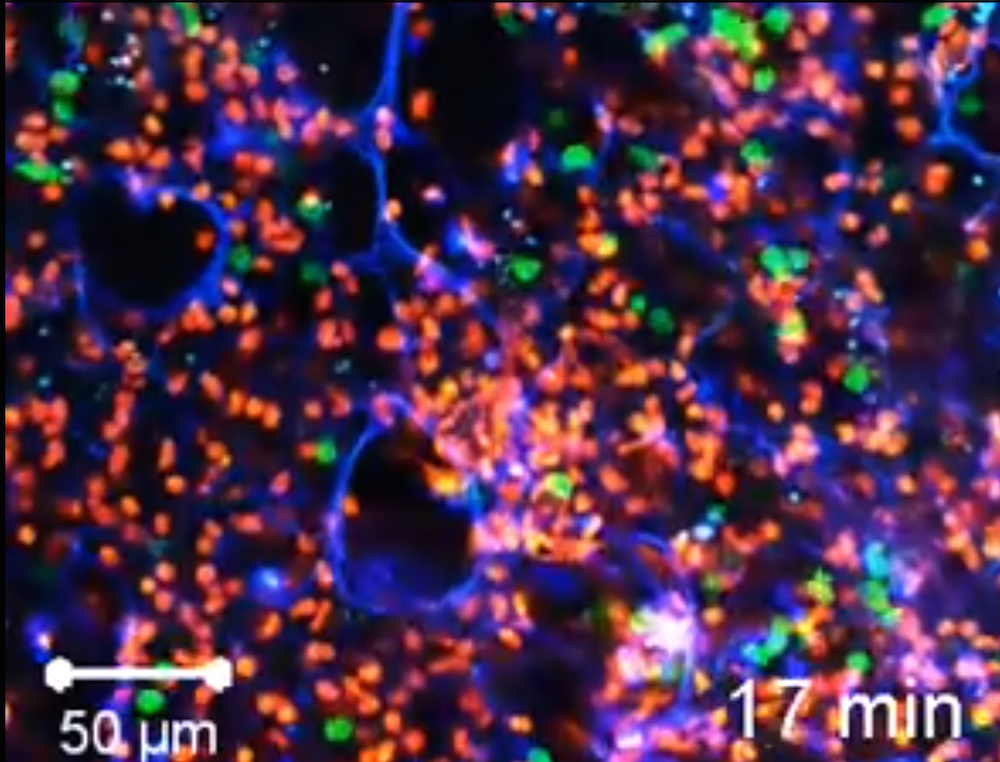Invasive aspergillosis (IA) is life threatening fungal infection, especially for patients whose immune systems are weakened by chemotherapy or immunosuppressive drugs. People with deficient immune systems – such as patients undergoing hematopoietic stem cell transplantation, chemotherapy for leukemia, or AIDS – are at greatest risk of IA.
Acute invasive aspergillosis occurs when the immune system fails to prevent aspergillus spores from entering the bloodstream via the lungs. Without the body mounting an effective immune response, fungal cells are free to disseminate throughout the body to infect major organs, such as the heart and kidneys. Aspergillus fumigatus is considered by many pathologists to be the world’s most harmful mold, with an associated mortality rate of up to 90% and accounting for around 600,000 deaths annually worldwide.
Aspergillus is a ubiquitous organism capable of living under extensive environmental stress. It is estimated that most humans inhale thousands of Aspergillus spores daily, but they have little impact on most people’s health due to effective immune responses. Taken together, the major chronic, invasive and allergic forms of aspergillosis account .
Despite the critical need for early detection, IA remains difficult to diagnose. A study in The Journal of Molecular Diagnostics compared three diagnostic tests and found that the combination of nucleic acid sequence-based amplification (NASBA) and real-time quantitative PCR (qPCR) detects aspergillosis with 100% accuracy.
The A. fumigatus mold is ubiquitous in the environment and is found on decaying plant matter. For healthy individuals exposure to the fungus can be inconsequential, but it can cause significant morbidity and mortality for those with compromised immune systems, including patients who have undergone organ transplants or have advanced AIDS. Even patients with more modest immune impairments, such as diabetes, poor nutrition, steroid use, or lung disease, can become severely infected. Symptoms may include fever, cough, difficulty breathing, chest pain, seizures, and focal neurological problems.
According to lead investigator Yun Xia, PhD, “Traditional diagnostic methods, such as culture and histopathology of infected tissues, often fail to detect Aspergillus,”
In this retrospective study, scientists evaluated the diagnostic performance of two nucleic acid amplification assays (qPCR and NASBA) and one antigen detection method (galactomannan enzyme-linked immunosorbent assay [GM-ELISA]) using blood samples collected from 80 patients at high risk of IA. Of the 80 patients, 42.5% had proven or probable IA. The patients came from intensive care, hematology, neurology, nephrology, geriatrics, and other hospital departments.
The tests were evaluated singly and in combination. Individually, NASBA had the highest sensitivity (76.47%) whereas qPCR offered the highest specificity (89.13%). NASBA also was the test that best indicated that a patient did not have the infection (negative predictive value). The combination of NASBA and qPCR led to 100% specificity and 100% positive predictive value (the probability that subjects truly have the infection).
“Because each test has advantages and disadvantages, a combination of different tests may be able to provide better diagnostic value than is provided by a single test,” says Dr. Xia. The combination of NASBA and qPCR should be useful in excluding IA in suspect cases, thus reducing both suffering and expense for immunocompromised patients. On the other hand, the combination of NASBA and qPCR could be more suitable for screening patients suspected of infection, because this assay had the highest sensitivity.”
The authors note that NASBA offers the advantages of rapid amplification (90 minutes) and simple operation with low instrument cost compared with qPCR and GM-ELISA. They caution that although GM-ELISA is widely and routinely used for aspergillosis diagnosis, this study indicates that it had low sensitivity (52.94%) with reasonable specificity (80.43%), making it “inferior to both NASBA and qPCR.”
Sources:
1. Lipeng Wang, Yunyan He, Yun Xia, Xiaoyan Su, Huijuan Wang, Shumei Liang. Retrospective Comparison of Nucleic Acid Sequence-Based Amplification, Real-Time PCR, and Galactomannan Test for Diagnosis of Invasive Aspergillosis. The Journal of Molecular Diagnostics, 2014; DOI: 10.1016/j.jmoldx.2014.05.001















